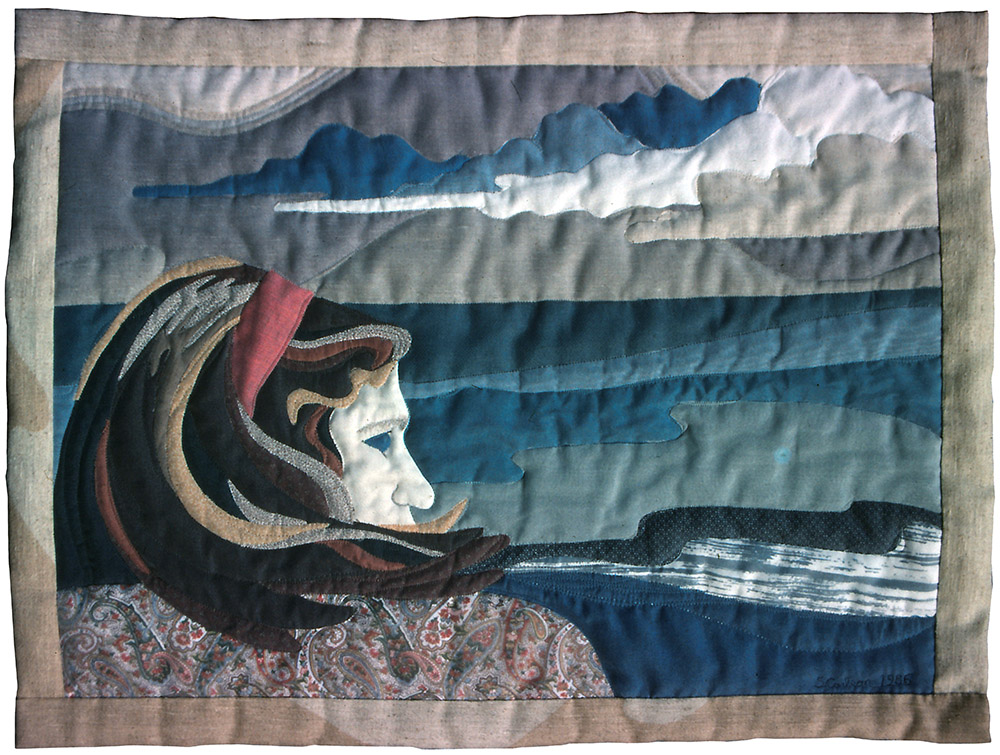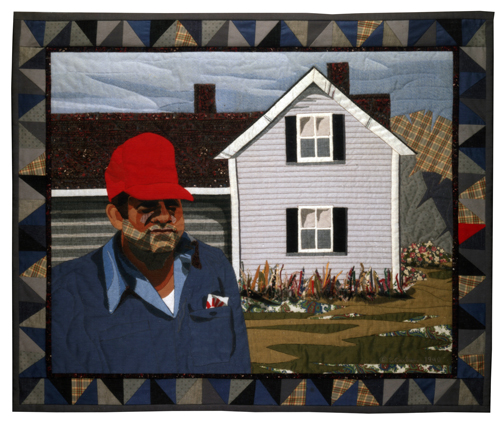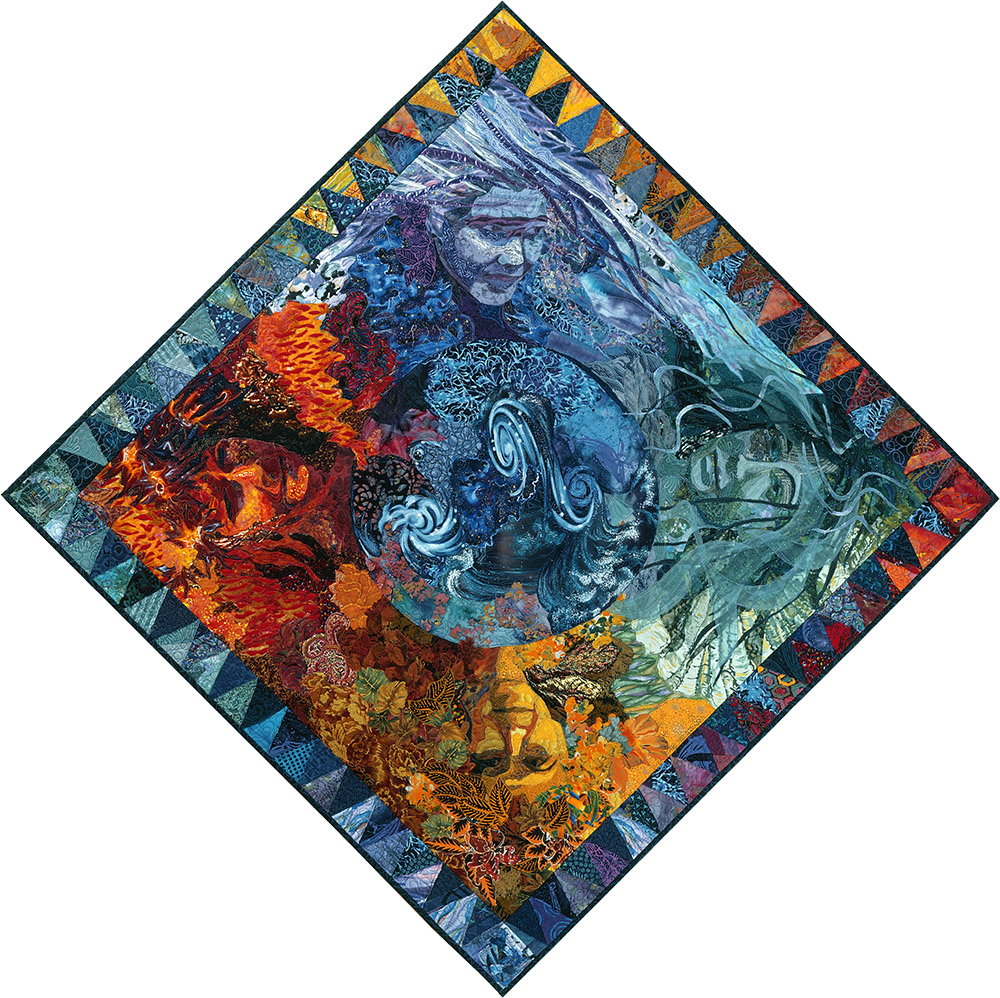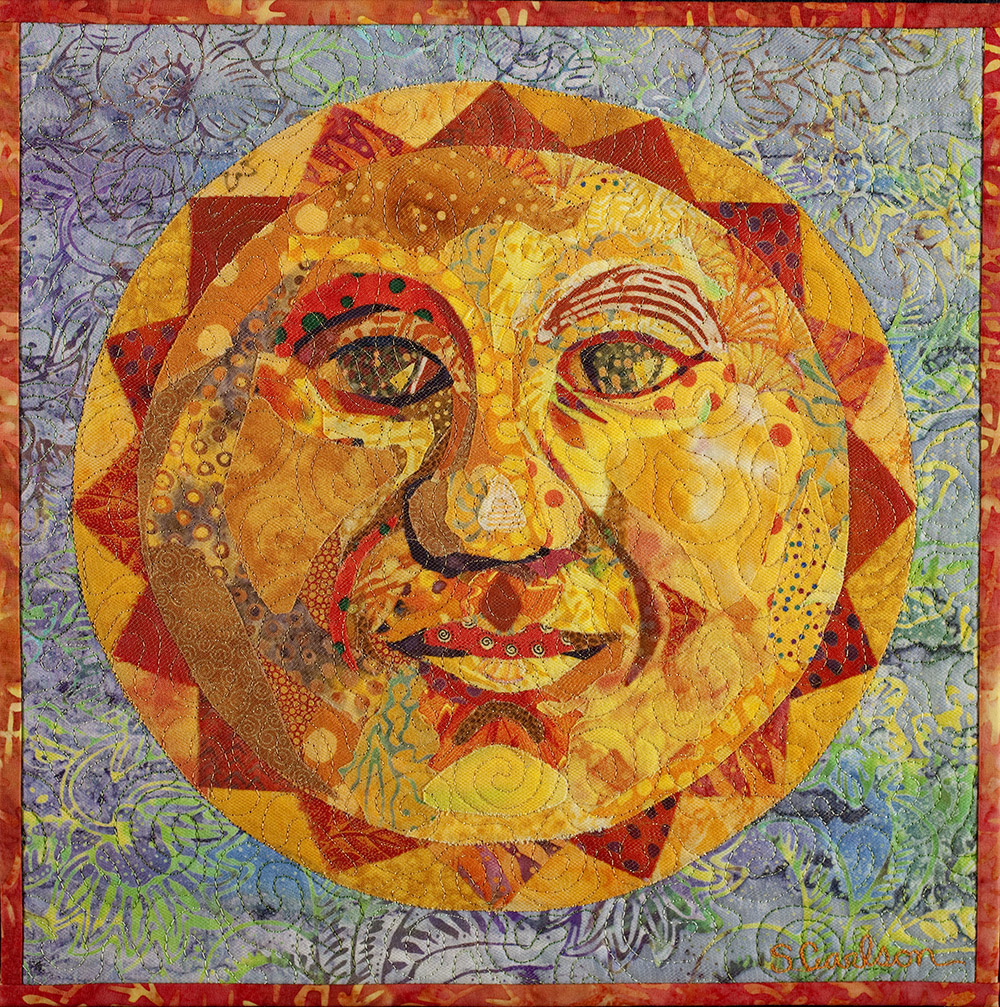Ahh, a sweet summer breeze lifting the sheer curtains (I can hear Seals and Crofts now)…. Wait! Could I use a bit of those curtains in my collage?!
I have, and I will again.
In my post Using Sheer, Netting, and other Semi-Transparent Fabrics, I showed how I use those sorts of translucent fabrics—including tulle—to create form and add detail in fabric collage. Another way I have used tulle (the very fine netting also referred to as Bridal Illusion) is as a final layer over the entire completed collage prior to quilting. While I almost never do this these days, in my classes I offer students this technique, which has both advantages and disadvantages.
So, when your image is ready to quilt, the question is: to tulle or not to tulle?
Ancient History
In the 1980’s I learned about a technique called “shadow quilting.” It involved raw-edge appliqué which was then sandwiched under a layer of translucent fabric and quilted along the appliqué edges. This disguised the raw edges and gave the piece a finished appliqué look but without the handwork involved.
I gave it a try with a portrait of my friend Kathryn (below)—based on a photo taken of her during my infamous summer visit to Maine where I met (my future husband) Tom. I transferred the original design to templates, cut out the shapes, and fused them in place. Then all was covered with tulle and free-motion quilted around the edges of the cut shapes. Aside from all that template cutting (not what I do anymore), it worked well for me.

Flash forward a few years and it’s now 1990 and I have this fabric collage—with glue and no templates—idea. I thought back to my shadow quilting experiments and now saw that layer of tulle as a way to help hold my multiple pieces of collaged fabrics in place.

All my early fabric collage pieces have tulle as a final layer overtop the entire quilt. At the time, I thought that a nice neutral shade of tulle, like beige, would work best. How much more basic can you get? I started by doing portraits of myself and my family. Being of northern European stock, our skin tones are pretty beige as well, so the problem with light colored tulle didn’t surface immediately.
The use of beige tulle became problematic only when I moved into “alternative” colors for portraits such as when I created Elements, using vibrant, rainbow spectrum colored fabrics in the faces.

So, I had the quilt top of Elements all finished and ready to assemble for quilting and I laid a large piece of beige tulle overtop the brightly-colored collage to prepare it for shadow quilting. You see, pale colored tulle reflects light back to the viewer. It’s not terribly evident when it’s over similarly light colored fabrics. However, when paired with bright colors, it dulls what’s underneath. Tom (never afraid to question me) happened to walk into my studio at that moment and our conversation went something like this:
Tom: [Bluntly] That’s unfortunate. Why are you doing that?
Me: [Defensively] It’s part of the process.
Tom: [Challengingly] What process?
Me: [Confidently] Shadow quilting. It holds all the edges down.
Tom: [Slyly] But don’t you glue and quilt along the edges anyway?
Me: [Doubtfully] Well, yes…
Tom: [Triumphantly] Then why do you need it?
Turns out I didn’t. And Elements is my first fabric collage quilt that is sans tulle.
What I have since learned (duh!) is that tulle comes in all sorts of colors—not just beige or white—who knew?! I’ve learned that dark colored tulle seems to absorb reflecting light and can even enhance dark fabrics underneath. It could be black, navy blue, maroon, dark plum or eggplant—all can work amazingly well depending on the primary colors in the fabrics used for the collage itself.
What it comes down to is that original question: to tulle or not to tulle?
Sometimes I still do, but most of the time I don’t. I think it goes back to Elements—I worked long and hard to get those colors “just right,” and even if I had known of and tried a darker tulle on it, it may have changed how I saw those colors too much for me. Though tulle is such a very fine netting that it doesn’t obscure the image, it does give a haze or cast of color to it. Could be good, could be not good.
To Tulle
Aesthetically, an additional touch of color might accent the collaged image or further the idea or “story” of a piece. Take my sun face, Simple Sol, below—a golden tulle intensified the yellow fabrics. Had I included many dark values in this face, the tulle would have dulled those dark fabrics and would not have worked as well. As it is, it’s hard to even see the presence of the tulle, it can blend in quite well if the color is right.

It’s a matter of trial and error and experience. I tell my students to take their completed quilt top into a fabric store that carries tulle and see what color looks good. Tulle is pretty cheap to buy, especially if you catch it on sale. You could even assemble a small collection to choose from at home.

Practically, tulle helps to hold down all the individual pieces of fabric used in the collage. I use glue for my collage process, starting with light smears of glue until I see how the collage is progressing. Fabric edges are loose for awhile so I can manipulate them—trimming down, tucking under, or pulling up. But when it comes time for quilting, those loose edges are a hazard to a machine’s quilting foot.
Continuing with tulle samples on my crazy spiral: upper left—a silver sparkle maroon tulle paired with a purple spotted tulle; upper right—a copper sparkle maroon tulle paired with the bright orange tulle.
I narrowed my favorites to the orange (below left) and the purple spotted tulle (below right). Side by side, you can see how each effects the spiral fabrics differently. And the winner is… the purple polka dots! Even Tom agreed. In the end, I didn’t like the way the orange dulled the darker values. The purple—being between red and blue on the color wheel, didn’t dull the reds and oranges too much and also let the blues come through. Plus, the spots are kinda fuzzy, a definite bonus.
When a layer of tulle is added to the final quilt sandwich—tulle, quilt top, batting, and backing—it secures the smaller fabric shapes beneath, without needing to go back and do more gluing (often a big advantage to my students—the monotony of gluing is not for everyone!) Plus, the quilting design can now be very free and easy, hitting the fabric edges underneath or not, since the layers will be bound together under the tulle no matter what.
Not to Tulle
As I mentioned earlier, I usually don’t add a final layer of tulle anymore, mostly because I don’t usually find any one color that I like over the entire image. I will, however, add it to the mix of various translucent fabrics for adding details (again, see Using Sheer, Netting, and other Semi-Transparent Fabrics).
The final details for my Kissin’ Cousins portrait below, were added that way—with small pieces of sheers, both printed tulle and various netting bits—to add highlights, shading, and general sparkle. Keep in mind that this step is separate from the “to tulle or not to tulle” question.
However, in this photo, I also auditioned an overall layer of the golden ochre tulle on the left and black tulle on the right, leaving an open space in between for comparison.

Now that I see it, I think I’ll leave this quilt without the final layer of tulle on top. Though the golden tulle is nearly invisible where it intersects Sam’s face, it certainly detracts from the dark values on his head. The black tulle on Maia’s side heightens the dark values, but shades the yellow’s of her face. I could keep looking at other colors of tulle, or say it’s done and move on.
No tulle as a top layer means I go back and glue down all the exposed loose edges of all the fabric pieces in the image. If that sounds like it can take some time, it does. But, as I tell my students (and myself with every quilt I do this way), what’s a few hours—or days—in the grand scheme of the life of a quilt? You only have to do it once.
In Conclusion
To tulle or not to tulle, that is the question, and it’s up to you whether you employ it for the purpose of shadow quilting. No matter what, tulle, nettings and other transparent fabrics are extremely useful in fabric collage. Whether you use them over the entire image or only to enhance parts of it, they’re worth having in your fabric arsenal. Have a bunch of different colors on hand. Include some with patterns, flocking or sparkles in them. Oooh… shiny.
And remember, using sheers in any way means you have one more excuse (as if you needed one) to add to your collection of fabrics.





I do not create with your technique (yet?) but I appreciate all the work and clear explanation (words & pictures) that went into this post. Thanks for sharing.
Thanks for sharing your process of whether or not to use tulle! I really enjoy your blog. It’s like a mini lesson!
I found an “all purpose” tulle that I had my (few) students use when I had them try unstructured constructions. It was an orange/red. It sort of went over everything and made it all look cohesive. I usually followed your lead and had a bag full of different tulle for them to try– the orange/red with a bit of sparkle usually was the ‘one”.
As always, love reading your posts.
Hi Joanne – yes, tulle in the red family are good bets, and sparkle is always a great touch! I’ll keep my eyes open for a tulle like that to add to my stash. PS – it was nice to run into you at MSMT.
You are such a generous teacher, you share so much information. I used your Serendipity book to make a sun and Moon and it was so much fun. People were so impressed that I could create pieces like this from a book.
Thank you again for your generosity. Love getting your posts.
Another wonderful, educational post. I have a couple of questions. It could be part of another post. How do you use tulle to only emphasize one part (as in Simple Sol?) of your collage? Does it get tucked under? Thank you for sharing.
Hi Angie, thanks! Simple Sol actually does have the golden tulle over the whole piece, background included. It blends in so well because even the blue of the background has some warmth to it and is a medium value. Tulle can also be used to emphasize smaller areas. The first “sheers” post I referred to in this post may answer some of the questions you have. Here’s the link again: https://susancarlson.com/2017/01/07/using-sheer-netting-and-other-semi-transparent-fabrics/
So interesting!! Love your blog–thanks!!
As always, Thanks for being so generous with the info you share here!!! Love your work <3
Thank you for taking the time to develop such an informative post! I sent you an email today with this exact question, and Tom was kind enough to point me to the article.
Please send me your blog
Here’s where you subscribe: https://susancarlson.com/subscribe/. Thanks.
This is the first I have heard of shadow quilting. I am working on a large 85 x 55 inch quilt with tiny pieces all over it. It is entirely a raw edge applique quilt. I have not sewn any of the pieces to keep them in place as I have glaucoma and very difficult to see small pieces of applique. I used soft fuse and the larger pieces seem to be staying on. Would your process work for me on such a large quilt? At this point, since I can’t sew them on, would shadow quilting be feasible? Thank you
Hi Toni! Your piece sounds interesting and yes, I think that shadow quilting may be a good technique for you to use. There’s a fiber artist I know, Natasha Kempers-Cullen, who (among other things) arranges small pieces of fabric on a base, covers all with a large piece of tulle, pins the heck out of it, and carefully quilts through the layers to hold it all in place. Some of her work is large, and all of it is gorgeous. You should search her out. I didn’t find a website for her but it looks like she’s on Facebook. Hope that helps with your creating!
Thanks for your very interesting explanation of the evolution of your technique. I’ve been using tulle on landscape and art quilts for sometime now; I invested in a full range of colors and it’s fun to see, as you pointed out, how it changes the look. Most recently, for a quilt portraying Puget Sound at sunset, I wanted different color trees on Blake Island but basically they needed to read as black silhouettes. I tried plain black silhouettes but it was boring; switched to a variety of dark green fabrics as well as black and that was distracting. But wait, I covered the latter in two layers of black tulle and it was perfect!